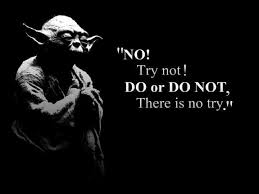In my last three posts, I described our two-year journey to Agile marketing at CA Technologies, including two of the three pivotal moments that convinced me to keep going and scaling. The most recent, Beware of Agile Theater, taught me what real agile was and how it could benefit the business.
Despite seeing the benefits of Agile marketing, it took one more “in my face” moment to persuade me to take the next step in scaling it across our marketing organization at CA.
The Lord Vader Project
In August 2016, the request was made to be more confident in our messaging, to create more digitally discoverable comparative content, and to execute fact-based competitive campaigns for some of our products. Seven product lines were asked to identify a nemesis, a “Lord Vader," in their category and to put forward more compelling, fact-based, and comparative information.
In November, after the campaign elements were delivered and in market, we assembled representatives from each of the seven teams for a retrospective (aka retro) to see how they worked, what they experienced, and how could we improve.
One team was from the Agile delivery group I previously described.
The other six were not, but rather were individuals brought together from different marketing functions required to collaborate on this campaign.
The Force Awakens
In one of the retro breakouts, each team was asked to put a timeline on the wall to map their activities along with each participant’s relevant work, engagement, visibility into progress across the team, and their feelings on how it went.
Feelings may seem a strange request in a business review, but we asked them to use smiley faces – or not – to express how they were feeling at each point in time.
The six non-Agile "teams" had each worked together before, but they were not teams – just collections of capable individuals representing their departments (reminds me of the Miracle on Ice movie where in the beginning all the hockey players self-identified with their college program and not with the USA Olympic Hockey team to which they now belonged).
Not surprisingly, they had poor results from this project that required significant cooperation:
- Ownership and accountability was unclear and they reported a lot of waiting around.
- They took ages to get started as they waited for someone else to kick-it off. One bold team member admitted he spent 2 weeks doing nothing on the project but wondering what a "Lord Vader" was (hint: Darth Vader; the competitive foil for the campaign). He didn’t ask or escalate but rather waited and wondered.
- They each juggled this priority against the other departmental objectives they had, all with differing degrees of importance.
- Throughout the project, visibility into what other team members were doing was reported as poor and the status of others’ deliverables was unclear. When a dependent task or content was completed and thrown over the fence, the recipients were surprised. They then had to wrap-up the other time-filling task they had started before they could get to their next step in this project.
- Each of the teams’ members had lots of frowny faces. The Empire was winning.
In contrast, the Agile delivery team had the advantage of already being a real team. They:
- Took common ownership and accountability for the outcome.
- Collectively prioritized the campaign against their other work.
- Mapped out the dependencies they had on the different elements and on each other.
- Synchronized the work across the team and across their 2-week sprints so each person knew who was doing what and when.
- Stayed aligned via the Agile ceremonies, specifically the 2-3 stand-ups per week and bi-weekly sprint planning.
- Received stakeholder input from sales and BU management as part of their normal ceremonies.
- Pivoted twice because of real-time stakeholder input and feedback on content/tactics (recall they had digital sales represented on their cross-functional team).
- Their team members reported no frowny faces (despite the project being a lot of work).
Do. Or do not. There is no try – Yoda
Despite starting with the least amount of available competitive research and the least number of comparative assets required for completion, the Agile delivery group finished first….and iterated/pivoted twice along the way.
They were easily twice as fast getting their campaign into market, considering their disadvantaged starting position.
As a true cross-functional and Agile team, they knew how to make things happen and started immediately prioritizing the work for this project with their other, current work (no one sits idle waiting for a Lord Vader project to happen).
While they started behind the other groups in terms of assets, they scheduled analyst meetings right away, commissioned third party research and got the competitive information they needed. They weren’t wasting any time.
Shared ownership, accountability and empowerment enabled them to make the decision to pivot – twice – based on stakeholder input…without getting their bosses’ approval because they knew and were aligned on the business objective.

It’s worth noting that an eighth team, representing another product line in the Agile delivery group, that was not asked to participate in the campaign, decided to also do it. They leveraged the same instructions, guidance, and templates yet had none of the forced management reviews…and came in tied for first/best.
Always pass on what you have learned – Yoda
Without a doubt, I saw that Agile made a difference in engagement, velocity and quality.
It was time for us to further scale it up. I rang up our CMO, shared what we had learned and we decided to scale our adoption of Agile marketing to seven additional cross-functional campaign teams.
And in acknowledgement of Yoda’s wisdom, I plan to write an article, sharing some of the learnings from our journey and what I wish I knew before embarking.
May the Agile force be with you!




